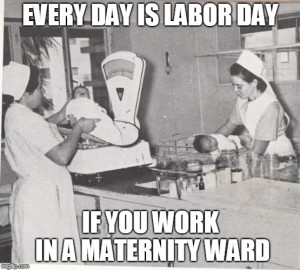Happy Monday, dear readers!
The summer is quickly drawing to a close, and soon children will be returning to their classes, young men and women will be returning to their college or grad school campuses, and the brave citizens of California’s workers’ compensation system can return to the soul crushing routine of denying benefits, litigating panels, and watching heaps of slack catapulted at applicants.
Once in a while though, the defense community gets to see a victory unfold, typically a small one, to help restore our faith in the needle of sanity that, as legend has it, exists in the chaos of workers’ comp.
While doing some research recently I stumbled upon the case of Bounthonv. Safe Streets USA, LLC. In this panel decision, the WCAB affirmed the WCJ’s opinion that defendant’s offer of work precludes an entitlement to TTD benefits.
The typical case which we all encounter is this:
Applicant: “Oh boy, I sure would love to go back to work. I hate sitting around the house, doing nothing, secretly working my second job while I collect TTD benefits. If only my employer could accommodate my work restrictions, I would gladly get back to it!”
Employer: “We found this charity that can put you to work to accommodate your work restrictions. We’ll pay you your normal wages and the charity will get the proceeds of your labor for free. Everybody wins.”
Applicant: “…”
Employer: “…”
Applicant: “Not like that…”
So then you have the Bounthon v. Safe Streets USA, LLC case, which I stumbled upon recently doing some research on unrelated matter.
Therein, applicant sustained an admitted injury while working as a security alarm installer. Defendant made an offer of alternative modified work with job duties available at the Salvation Army (Salvation Army was not associated with this case at the time of injury and is a separate entity, not the original employer).
After attending orientation at the Salvation Army, applicant declined the job but stood ready and able to accept and cash temporary disability checks. At the expedited hearing that followed, he advanced the theory that his employer could not offer him work for another employer.
Applicant also alleged that because the Salvation Army is a Christian organization, “requiring” applicant to work there violations a host of his rights under the United States Constitution, including freedom of religion, and freedom from involuntary servitude (at trial, applicant claimed that “working for the Salvation Army was a form of ‘modern-day slavery’”).
The WCJ, in finding the offer of work valid, noted that no evidence was offered at trial as to what applicant’s religious beliefs were or why working at the Salvation Army would violate those beliefs.
Part of the WCJ’s reasoning was that Labor Code section 4657 provides that temporary disability benefits should be based on loss of physical ability or earning power caused by the injury. The Labor Code gives no regard to ability to earn, not where the employee earns the money. To quote the WCJ: “an employee is expected to earn the wages that his injury will allow, regardless of where they are earned.”
The WCAB denied applicant’s petition for removal.
This is certainly a reasonable and positive result for the defense community, and, really, for the workers’ compensation community. Returning to activity that is medically permissible is a good thing. If that activity consists of stocking shelves of donated sweaters at a Salvation Army instead of stocking shelves of new sweaters at a Gap, the end result is the same: productive labor and a lessening of the addictive and destructive pull of idleness.
But, aside from the result making sense, I would add a bit of analysis of my own. Labor Code section 4658.1(c) specifically defines “alternative work” as “work that the employee has the ability to perform, that offers wages and compensation that are at least 85 percent of those paid to the employee at the time of the injury, and that is located within reasonable commuting distance of the employee’s residence at the time of injury.”
By contrast, subsection (a) defines regular work as “the employee’s usual occupation or the position in which the employee was engaged at the time of injury…”
In other words, the Labor Code specifically contemplates that “alternative work” will be based on (1) employee’s ability; (2) wages; and (3) reasonable geographic location. The legislature could have added requirement of the same employer or business entity, but chose not to.
Just from my own, small and humble practice, I am seeing an increase in such offers. Not every employer (or location for a larger employer) can accommodate work restrictions imposed by the various physicians. But, typically, non-profit charity work is available to accommodate very light restrictions. The benefits to all parties that are ethical and honest, are undeniable: the charity gets assistance in doing work pro bono publico, the employee continues to be active and is driven to return to work (to quote Benjamin Franklin – “I think the best way of doing good for the poor, is not making them easy in poverty, but leading or driving them out of it.” So too, hour humble blogger submits, for those on temporary disability – it is a far greater service to guide such injured workers out of needing temporary disability benefits, rather than make them comfortable and inclined to continue needing and receiving them), and the employer gets the benefit of an active employee eager to return to work.
What right can an injured worker assert not to perform volunteer work within his or her restrictions and receive the same pay? Of course, “I don’t want to!” is not a persuasive reason.
What do you think, dear readers – is your humble blogger missing something? Is it beneath one’s dignity to do work for a charity? Is the greater religious mission of a charity organization that does not discriminate in the beneficiaries of its charity a good reason to reject an offer as described above?




